I do think it is more than advisable for newspapers to bring citizens together and listen to what they have to say. We sponsor debates of office seekers, so why not sponsor discussions by voters? Whether a paper wants to commit to following the consensus, should there be one from those meetings, is an option that we might not all embrace.”
Matt Storin, Editor, The Boston Globe
Batten Symposium, May 14, 1996 |


Citizens don’t all act alike. Some are willing to talk to reporters about community problems, but reluctant to do so in public groups. Others are more active; they are willing to deliberate in public or volunteer for specific tasks. Civic journalism efforts have to acknowledge these differences.
Part of the “framing” process is to determine the nature of potential citizen participation. Do you want people simply to inform your reporting, to serve as experts on their every-day lives? Do you want them to offer individual opinions or actually to come together to deliberate? Do you want readers to come up with suggestions or to volunteer their services? Or do you want them to propose a specific task and see that it is carried out?
Getting started means getting straight about what the newspaper will do and what’s expected of readers. It also provides an opportunity for the news organizations to be clear about the limits of their roles and to lay out expanded roles for citizens.
Reader participation can fall into one of three categories:
- “Talking it through.” Sometimes what’s needed are outlets for public opinion. These could be as simple as quotes from readers in the paper or as complex as deliberative town forums on specific issues. The objective is to have ideas expressed, discussed and deliberated.
- “Getting involved.” Other civic journalism projects invite a more active participation and often provide specific roadmaps for potential volunteers. Opportunities for volunteering range from tutoring learning-disabled children to paying for park lights in an economically depressed neighborhood. Citizens are invited to respond, quietly and individually if they wish, and the news organizations often list ways they can do that.
- “Getting organized.” At the high end of the scale are initiatives that encourage citizens to band together in groups — task forces or action teams — to work toward specific goals. This active civic engagement is harder to create and sustain, but produces more concrete results when done effectively.
TALKING IT THROUGH
Whether the setting is an election campaign or statewide concern with the budget, the media partners in Madison, including the Wisconsin State Journal, have years of experience in getting people together for discussions, forums, and civic exercises — most of them televised statewide.
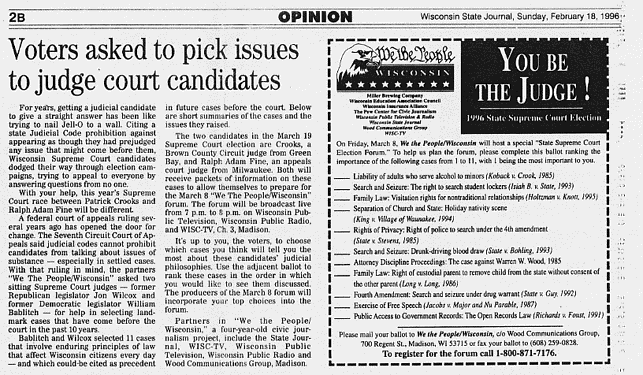 |
|
“The Public Agenda” in Tallahassee is a community-wide dialogue on issues that has spawned numerous smaller, independent groups discussing crime, race, growth and the environment, jobs, and teens. Both the larger conversation and its offshoots work on the theory that if people can talk with one another, they can work with one another.
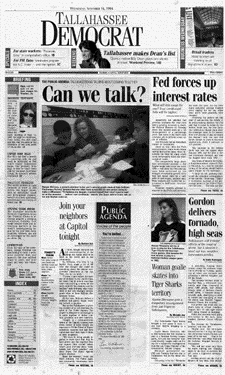 |
|
When the partners sought to bring citizens face to face with the two candidates for the State Supreme Court — always a difficult race to cover — they had to navigate around court rules that prohibit candidates from addressing issues that might come before the court. Instead, they asked the candidates to talk about settled cases that could be cited as future precedents. With input from two sitting judges, they developed a list of 11 landmark cases and invited citizens to rank their importance as topics for a community forum.
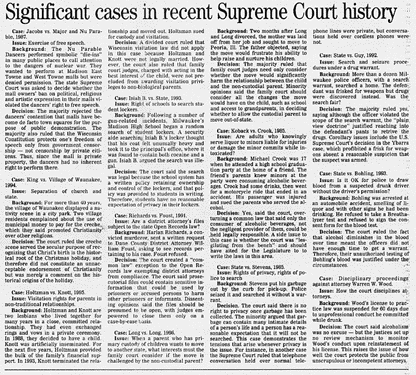 |
|
The Portland Newspapers, WGME-TV and Maine Public Broadcasting helped a group of about 50 citizens in the town of Sanford question candidates for political office and hold community discussions on local issues in the year-long “Maine Citizens Campaign.”
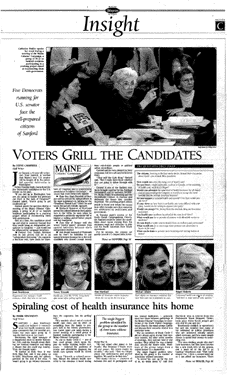 |
|
At the end of the year, the citizens wanted to stay together, but move from talk to action. Now, the citizens are involved in a “solutions” phase, which is being covered by the media partners.
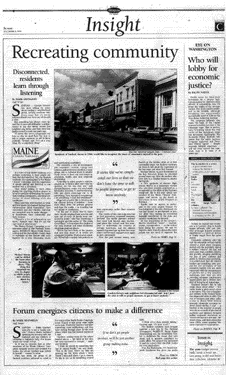 |
|
GETTING INVOLVED
In Charlotte, more than 1,000 citizens volunteered to help in “Taking Back our Neighborhoods,” a project by The Observer, WSOC-TV and two radio stations to uncover and deal with the systemic causes of crime in 10 neighborhoods. One of their most effective citizen-participation devices was a “needs” list proposed by residents of each neighborhood. These lists ran the same day the media partners did in-depth reporting on each area and itemized very specific donations or services that were needed — from sewing new drill team uniforms to restoring houses. The lists always gave a phone number for readers to call to volunteer.
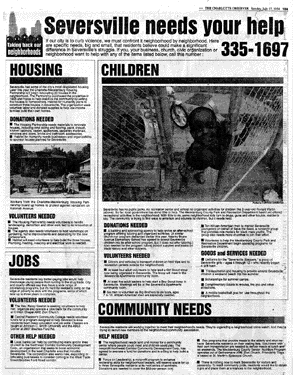 |
|
Inviting potential citizen-volunteers to meet community needs resonated with Charlotte’s citizens and The Observer was quick to applaud those who stepped forward, often publishing their names the very next day in the paper.
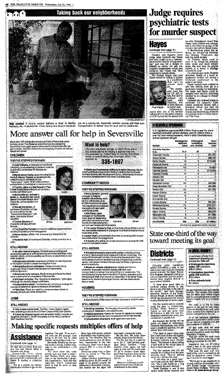 
Charlotte’s ideas became a model used by other projects around the country. The Sun News used a similar approach in its coverage of “Racepath,” a struggling neighborhood in Myrtle Beach, S.C.
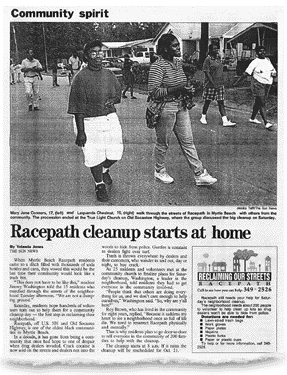 |
|
Charlotte also successfully involved citizens on panels in each target neighborhood to work with reporters and editors in identifying the problem. The media partners followed with stories on the problem and how people could get involved in solutions.
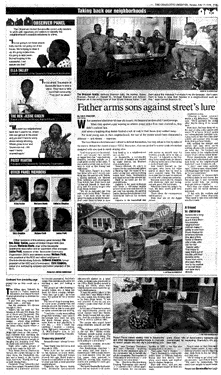 
Another tactic is to highlight not only what’s wrong, but also what’s working. In Charlotte, The Observer perfected a one-two presentation: On Sunday, it would publish a major take-out on a neighborhood in trouble, then follow up on Monday with a story package on a neighborhood that had overcome some of its problems. The result gave citizens a sense of the possibilities.
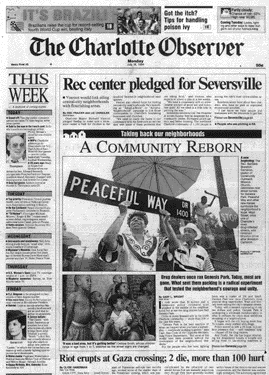 |
|
Many of these approaches can be taken to daily journalism. When the North Carolina legislature required local school districts to increase parent participation, The Observer invited readers to volunteer and published a list of specific ways to do so, again with a phone number to call. The newspaper kept a database of the volunteers and plans to monitor results.
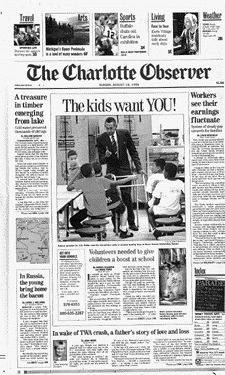 
GETTING ORGANIZED
After Binghamton, N.Y., was hammered by corporate downsizing, more than 200 of its citizens responded to invitations in the Press & Sun-Bulletin, WSKG public television and WBNG-TV to join community discussion groups. Citizens formed 11 “action teams,” each addressing a particular topic — everything from business development to community morale and beautification. After a summer of discussion and gathering information, the action teams reported out their recommendations and the media covered them.
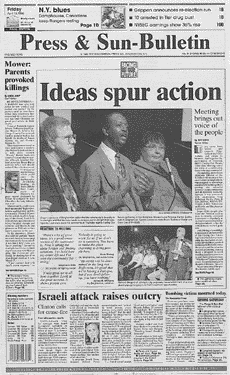  |
|
After the Argus Leader in Sioux Falls, S.D., selected Tyndall to be its “Community on the Rise,” citizens rolled up their sleeves to get the job done, and the paper reported back to readers what kinds of things were underway.
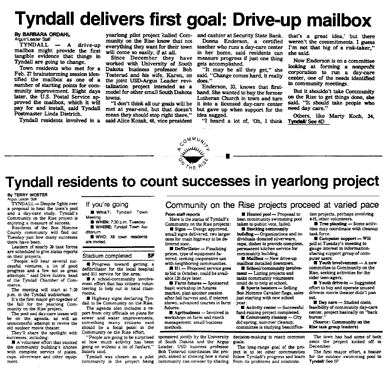 |
|
It began with an investigative series in the San Jose Mercury News on the influence of money on the state legislature. Then the paper and KNTV (ABC) invited citizens to learn more by signing up for the “Your Voices Count” initiative. About 75 citizens came forward and divided themselves into teams. One team created a “Legislative Statement of Accountability” and asked all legislators and candidates to sign it. Other teams sponsored a televised Citizens Inquiry Panel on money in the state legislature and produced a town hall meeting with eight legislators talking with an audience of more than 500 people. Another group created an Internet site to help citizens research pending legislation.
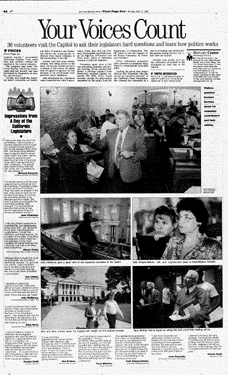 (IMAGE 30K) (IMAGE 30K) 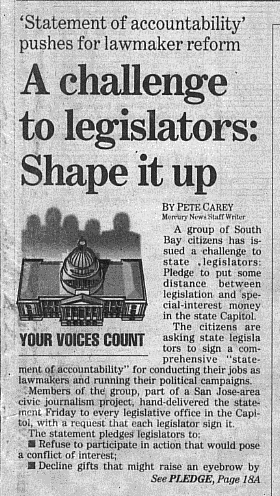 |
|
BACK TO TABLE OF CONTENTS | BACK ONE PAGE | READ THE NEXT SECTION
| | | |

















 (IMAGE 30K)
(IMAGE 30K) 